Aracari
An aracari or araçari (US: /ˌɑːrəˈsɑːri/ AR-ə-SAR-ee,[1] UK: /ˌærəˈsɑːri/ ARR-ə-SAR-ee, /-ˈkɑːri/ -KAR-ee)[2] is any of the medium-sized toucans that, together with the saffron toucanet, make up the genus Pteroglossus.
| Aracaris | |
|---|---|
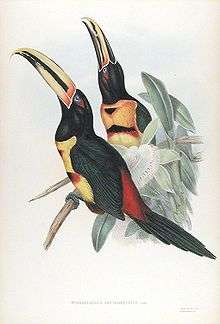 | |
| Pale-mandibled aracari Pteroglossus erythropygius | |
| Scientific classification | |
| Kingdom: | Animalia |
| Phylum: | Chordata |
| Class: | Aves |
| Order: | Piciformes |
| Family: | Ramphastidae |
| Genus: | Pteroglossus Illiger, 1811 |
| Species | |
|
14 (incl. the saffron toucanet), see text. | |
| Synonyms | |
| |
They are brightly plumaged and have enormous, contrastingly patterned bills. These birds are residents in forests and woodlands in the Neotropics.
Taxonomy and systematics
One species, the distinctive saffron toucanet, was formerly placed in the monotypic genus Baillonius, but Kimura et al. (2004) showed that it belongs in the genus Pteroglossus.[3]
Extant species
Fourteen species are considered to belong to the genus Pteroglossus:[4]
| Image | Scientific name | Common Name | Distribution |
|---|---|---|---|
_-Bronx_Zoo-8-4c.jpg) | Pteroglossus viridis | Green aracari | lowland forests of northeastern South America (the Guiana Shield), in the northeast Amazon Basin, the Guianas and the eastern Orinoco River drainage of Venezuela |
 | Pteroglossus inscriptus | Lettered aracari | Bolivia, Brazil, Colombia, Ecuador, and Peru |
| Pteroglossus bitorquatus | Red-necked aracari | Bolivia and Brazil | |
 | Pteroglossus azara | Ivory-billed aracari | Bolivia, Brazil, Colombia, Ecuador, Peru, and Venezuela |
| Pteroglossus mariae | Brown-mandibled aracari | Bolivia, Brazil, and Peru | |
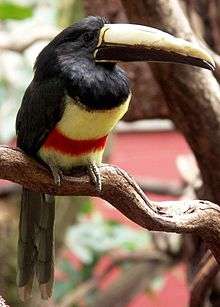 | Pteroglossus aracari | Black-necked aracari | Brazil, French Guiana, Guyana, Suriname, and Venezuela. |
.jpg) | Pteroglossus castanotis | Chestnut-eared aracari | Amazon Basin, Paraguay, Bolivia, southeastern Brazil and the extreme northeast of Argentina |
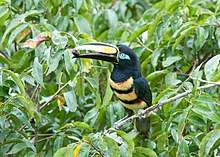 | Pteroglossus pluricinctus | Many-banded aracari | Brazil, Colombia, Ecuador, Peru, and Venezuela |
.jpg) | Pteroglossus torquatus | Collared aracari | southern Mexico to Panama; also Ecuador, Colombia, Venezuela and Costa Rica. |
| Pteroglossus sanguineus | Stripe-billed aracari | Colombia and Ecuador | |
| Pteroglossus erythropygius | Pale-mandibled aracari | Ecuador and Peru | |
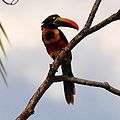 | Pteroglossus frantzii | Fiery-billed aracari | southern Costa Rica and western Panama |
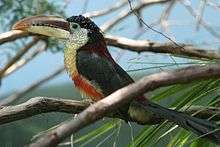 | Pteroglossus beauharnaisii | Curl-crested aracari | Amazon Basin |
 | Pteroglossus bailloni | Saffron toucanet | Brazil |
Former species
Some authorities, either presently or formerly, recognize additional species or subspecies as species belonging to the genus Pteroglossus including:
- Wagler's toucanet (as Pteroglossus wagleri)[5]
- Emerald toucanet (as Pteroglossus prasinus)[6]
- White-throated toucanet (as Pteroglossus albivitta)[7]
- Black-throated toucanet (as Pteroglossus atrogularis)[8]
- Groove-billed toucanet (as Pteroglossus sulcatus)[9]
- Crimson-rumped toucanet (as Pteroglossus haematopygus)[10]
- Guianan toucanet (as Pteroglossus Culik)[11]
- Golden-collared toucanet (as Pteroglossus reinwardtii)[12]
- Langsdorff's toucanet (as Pteroglossus langsdorffii)[13]
- Tawny-tufted toucanet (as Pteroglossus nattereri)[14]
- Gould's toucanet (as Pteroglossus gouldii)[15]
- Spot-billed toucanet (as Pteroglossus maculirostris)[16]
- Gray-breasted mountain toucan (as Pteroglossus hypoglaucus)[17]
- Hooded mountain toucan (as Pteroglossus cucullatus)[18]
- Black-billed mountain toucan (as Pteroglossus nigrirostris)[19]
Behaviour and ecology
Some species of aracaris are unusual for toucans in that they roost socially throughout the year, up to six adults and fledged young sleeping in the same hole with tails folded over their backs.
Breeding
They are arboreal and nest in tree holes laying 2–4 white eggs.
Food and feeding
All the species are basically fruit-eating, but will take insects and other small prey.
Threats
The ischnoceran louse Austrophilopterus flavirostris is suspected to parasitize most if not all species of aracaris, with the possible exception of the green aracari (Price & Weckstein 2005).
References
- "Aracari". Dictionary.com Unabridged. Random House, Inc.). Retrieved 2012-04-20.
- "Definition for aracari". Oxford Dictionaries Online. Archived from the original on 2012-07-23. Retrieved 2012-04-20.
- "South American Classification Committee". Merge Baillonius into Pteroglossus. Archived from the original on 2008-05-16. Retrieved 2007-09-16.
- "Jacamars, puffbirds, toucans, barbets & honeyguides « IOC World Bird List". www.worldbirdnames.org. Retrieved 2017-02-20.
- "Aulacorhynchus wagleri - Avibase". avibase.bsc-eoc.org. Retrieved 2016-12-24.
- "Aulacorhynchus prasinus - Avibase". avibase.bsc-eoc.org. Retrieved 2016-12-24.
- "Aulacorhynchus albivitta - Avibase". avibase.bsc-eoc.org. Retrieved 2016-12-24.
- "Aulacorhynchus atrogularis - Avibase". avibase.bsc-eoc.org. Retrieved 2016-12-25.
- "Aulacorhynchus sulcatus - Avibase". avibase.bsc-eoc.org. Retrieved 2016-12-25.
- "Aulacorhynchus haematopygus - Avibase". avibase.bsc-eoc.org. Retrieved 2016-12-25.
- "Selenidera piperivora - Avibase". avibase.bsc-eoc.org. Retrieved 2016-12-28.
- "Selenidera reinwardtii - Avibase". avibase.bsc-eoc.org. Retrieved 2016-12-28.
- "Selenidera reinwardtii langsdorffii - Avibase". avibase.bsc-eoc.org. Retrieved 2016-12-28.
- "Selenidera nattereri - Avibase". avibase.bsc-eoc.org. Retrieved 2016-12-28.
- "Selenidera gouldii - Avibase". avibase.bsc-eoc.org. Retrieved 2016-12-28.
- "Selenidera maculirostris - Avibase". avibase.bsc-eoc.org. Retrieved 2016-12-28.
- "Andigena hypoglauca - Avibase". avibase.bsc-eoc.org. Retrieved 2016-12-28.
- "Andigena cucullata - Avibase". avibase.bsc-eoc.org. Retrieved 2016-12-29.
- "Andigena nigrirostris - Avibase". avibase.bsc-eoc.org. Retrieved 2016-12-29.
- BirdLife International 2004. Pteroglossus bailloni. 2006 IUCN Red List of Threatened Species. Downloaded on 27 July 2007.
- Price, Roger D. & Weckstein, Jason D. (2005): The genus Austrophilopterus Ewing (Phthiraptera: Philopteridae) from toucans, toucanets, and araçaris (Piciformes: Ramphastidae). Zootaxa 918: 1-18. PDF fulltext
External links
| Wikimedia Commons has media related to Pteroglossus. |
- Extensive Gallery on Toucans
- List of Toucans
- Toucan videos on the Internet Bird Collection